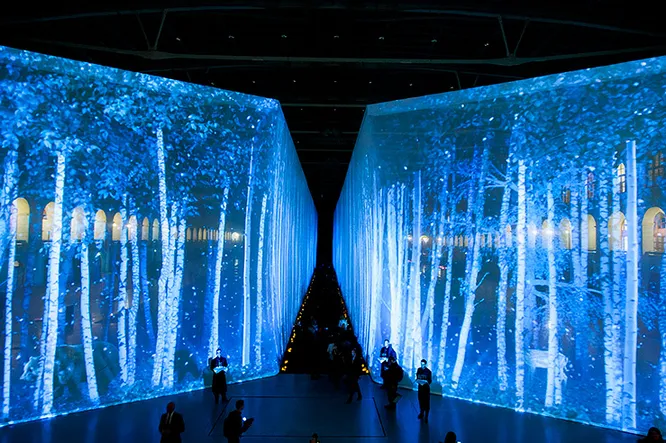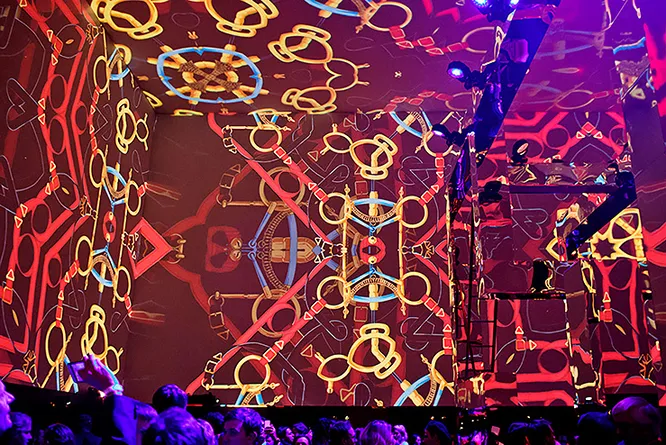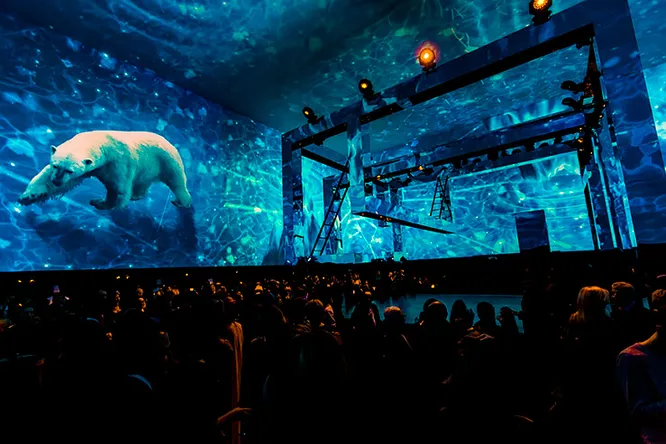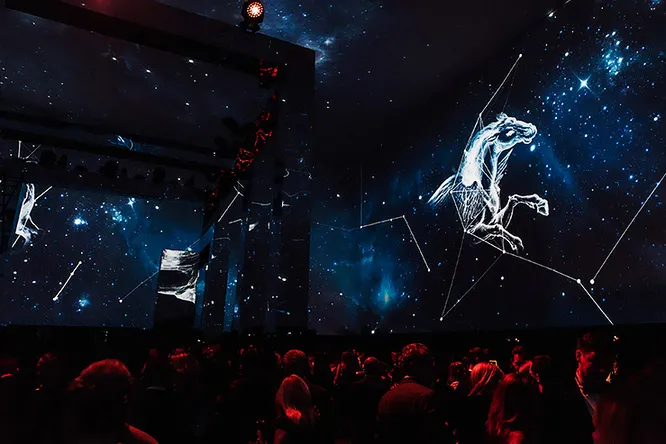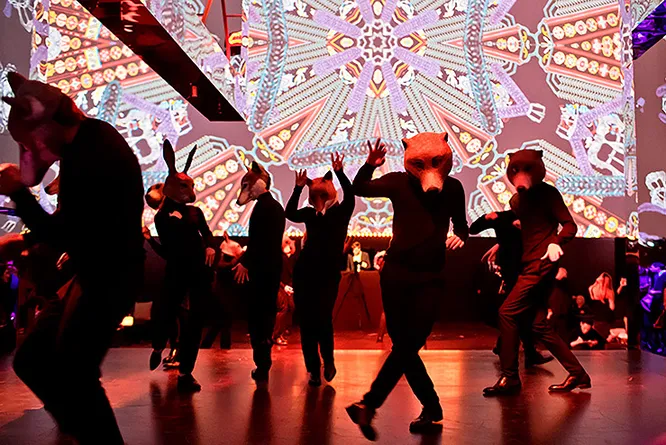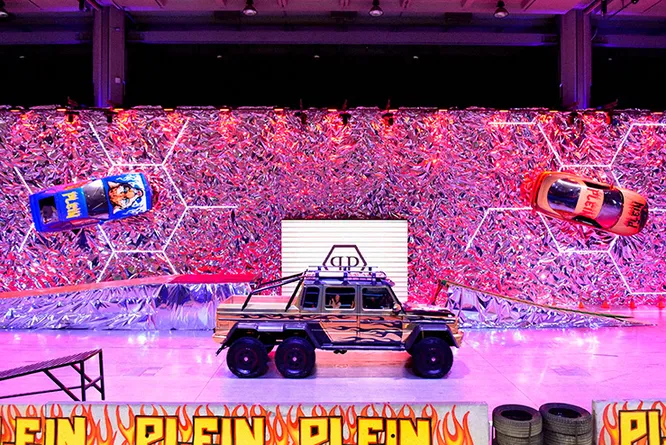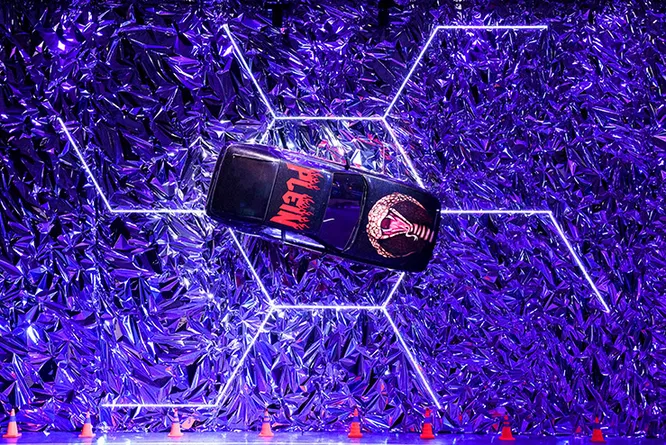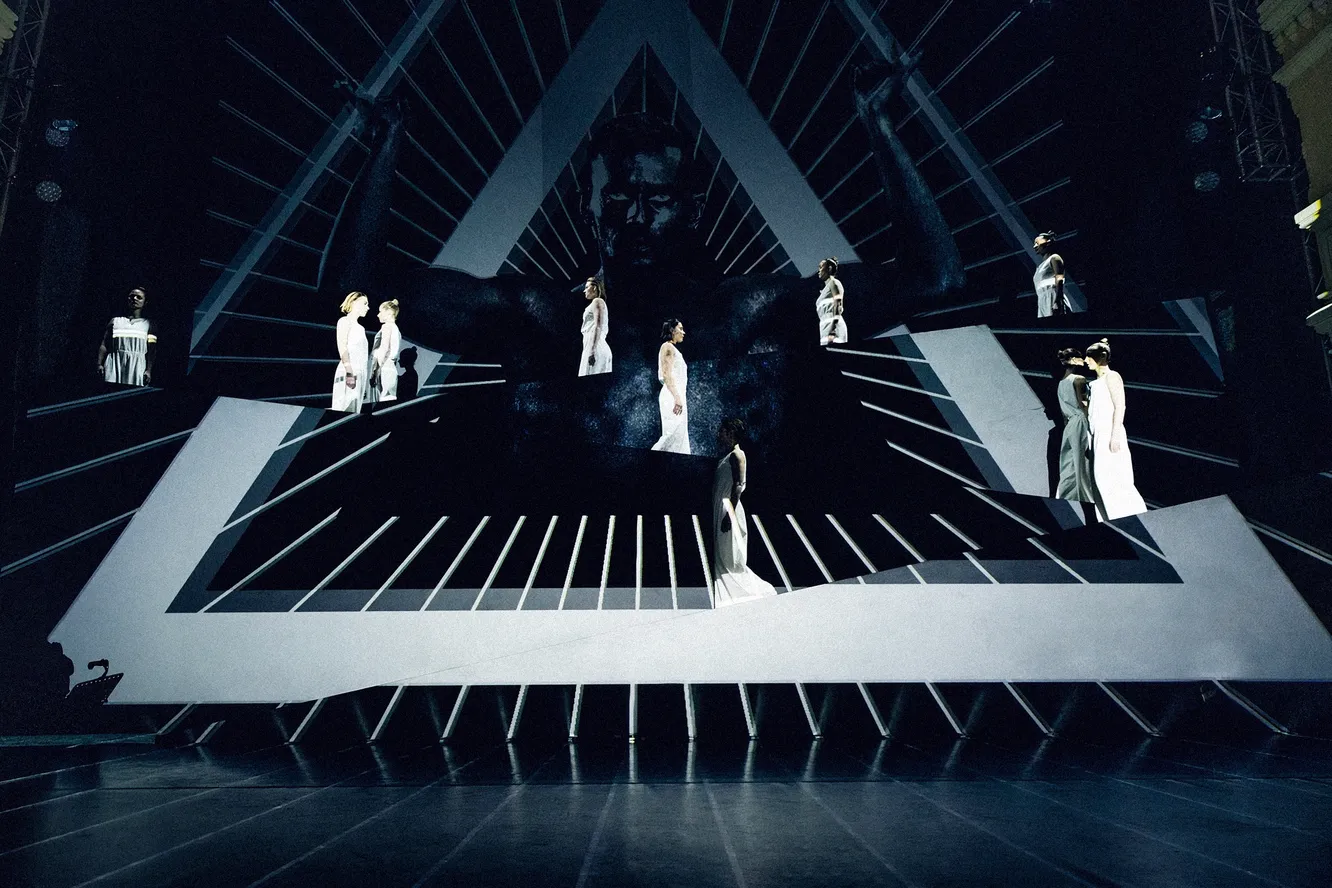"Some people walk the runway literally on pins": how luxury brands prepare their fashion shows"
17 minutes on the catwalk – and months of hard work on the backstage. Every world-class show that we see every season is an engineering masterpiece and a performance where everything is important, from the choice of fabric to the direction of the wind. There is no room for error, but there is a lot of creativity, risky decisions, and stories that the audience doesn't even know about. Our expert, who has been involved in the preparation of fashion shows for well-known luxury brands, shared insights about the behind-the-scenes of the fashion industry.
Dmitry Yakovlevsky is the founder of the international design laboratory TwentyFive and one of those who are responsible for the technical part of the fashion shows of luxury brands. He helps Louis Vuitton to make silk float in the air, Philipp Plein to build an underwater world, and Balenciaga to open up to the most daring ideas. In a conversation with the fashion department, he told how much time it takes to prepare a fashion show, what the atmosphere is like 10 minutes before the start of the catwalk, and how famous designers behave on the backstage.
Let's start from the beginning, as they say. Which fashion show was your first? How did you feel before the start?
The first show I did was for Lacoste, and then I did Kenzo and Dior. When you're first behind the scenes of a show like this, you can't help but wonder, "What am I doing here?" I had some experience in the industry, but it was minimal. The atmosphere backstage is a whole other world: the production managers are very friendly, but also incredibly detail-oriented.
Constant revisions, stress, and deadlines are a test that every newcomer to the fashion industry seems to have to pass.
The level of tension here is extremely high: everyone is afraid of making a mistake, there are frequent misunderstandings between departments, and the work schedule is almost never the same for all participants.
Everyone acts within the framework of their own tasks, not always considering the overall picture, and this also creates a certain level of discomfort.
How many people are usually involved in a screening?
If we talk about an average fashion show of a not-so-well-known contractor, the team usually consists of 20 to 40 people. If we are talking about a large show with an A-list, a buffet, and organization, then there are 60 to 100 people involved who interact with guests, artists, hostesses, organizers, and other participants. However, I am not considering the team that builds the set and organizes the show itself, as there may be significantly more specialists involved. And this, of course, complicates the process on a human level.
You've mentioned VIP guests (aka A-list stars). How demanding are they? And is it also part of the organizers' tasks to adapt to them?
The requirements of VIP guests depend on the field they represent. If we are talking about high-ranking officials or politicians, organizing their presence requires coordinating many parameters, from transportation routes and security to security protocols and confidentiality levels. And yes, we need to consider all of this in addition to our other tasks.
With representatives of the fashion, music and entertainment industry, interaction is more flexible: they usually adapt to the format of the show, while appreciating a personalized approach, attention to detail and comfort. It is important to understand that the presence of such guests is not only an element of prestige, but also part of the overall concept of the event, and therefore interaction is based on mutual respect.
Most problems arise not at the level of requirements, but due to insufficient logistics. From 10 to 20% of invited VIP guests may refuse to participate if they do not have a clear understanding of how to get to the venue, where the entrance will be, what traffic jams are expected, how the entrance is organized, and so on. It is important to work out all these nuances individually with each guest in advance.
There are similar examples outside the fashion industry. For example, at Jeff Bezos’s wedding, a portion of guests — according to various estimates, up to 15-20% — refused to attend due to inconvenient logistics: some were not satisfied with boat transportation, while others were displeased with long queues, lack of privacy, and poor service.
This clearly demonstrates that even if an event is large-scale and prestigious, without proper logistics and consideration of the individual expectations of VIP guests, you can lose a portion of your audience and, consequently, your reputation.
Let's go back to the topic of fashion shows. Tell us about the "flying silk" project for Louis Vuitton — how did the idea come about?
This project was implemented at the request of Bureau Betak. Their team developed sketches that attempted to visually convey the theme of airiness and lightness, which aligned with the brand's collection concept at the time. Our challenge was to find a technological solution that would allow the fabric to float in space while maintaining the aesthetic of LV's heavy luxury.
We tested more than ten different materials: chiffon, natural silk, and synthetic alternatives. The best results were achieved with two options: one was a silk from Japan, and the other was a synthetic material from Germany.
But when working with light fabrics, there are its own difficulties: not only with aerodynamics, but also with ventilation of the space itself. Air currents in the room interfered with the stable movement of the fabric, and to achieve the desired effect, it was necessary to use a heavier material and powerful air generators. This allowed to create a controlled trajectory of the fabric movement.
We conducted a series of tests — tested how materials behave in different conditions and how accurately they convey the brand’s visual message. The preparation took about 6-7 months.
Six months to approve just one material?!
Yes, and this is also not the end of the story. In the end, three final fabric options were selected and approved by the production team, the event agency, and the brand itself. To our surprise, the choice fell on a material that was less manageable from a technical standpoint. However, it met all the requirements for fire safety, certification, sustainability, and color reproduction...
And to achieve the effect of "floating", we used guides made of almost invisible transparent threads. Despite all the limitations (and believe me, there are a lot of them), the installation looked spectacular and large-scale — exactly as the spirit of the show required.
Have there been cases where the art director of a fashion house couldn't exactly explain what they wanted (which is not uncommon in creative teams), but still demanded the task be completed to the highest standard?
Such situations do happen. Most often, the art director understands what effect he wants to achieve, but he can’t always articulate exactly how to implement it technically. He has an aesthetic and conceptual vision, but he doesn’t have the tools to translate the idea into specific materials, technologies, and visual solutions. This is precisely our task – to interpret and translate artistic ideas into technically feasible forms.
This was the case, for example, at one of the Hermès shows in Moscow, which was related to the opening of a boutique. Similar situations often occurred in projects with Chanel. The creative team formulates the theme, mood, and style, but the details of implementation are developed together with us. This includes the selection of materials, the type of structures, movement mechanics, lighting, sound, special effects, and everything related to the technical aspects of the show.
It is important to understand that the art directors of major fashion houses like Chanel, Dior, Gucci, or Fendi are simultaneously overseeing several large-scale projects around the world. They do not have the resources to keep track of technological innovations, attend exhibitions, or search for unique solutions.
Therefore, they work with contractors who have relevant expertise and can offer fresh, unconventional approaches.
Have there been times when something went wrong a couple of days before a show, and you had to redo everything? How did you handle these situations?
Such situations happen quite often - especially at large events, where many external factors are involved. The reasons can be different: changes in the political agenda, problems with logistics, traffic jams, unexpected construction restrictions or technical failures on the site already agreed and paid for. In general, from the arrival of a political delegation, because of which half of the city is blocked, to the banal "laptop crashed".
Sometimes, in the days leading up to a show, it is necessary to completely change the location. For such cases, production teams always have a Plan B. We have worked with leading contractors from Germany, Belgium and the Netherlands, who have at their disposal rental tents and mobile structures, allowing to set up a new site from scratch in the shortest possible time.
For example, Dior has repeatedly moved its shows from the Grand Palais to alternative locations, such as temporary pavilions specifically designed for the collection's concept.
One of these tents was completely transformed into a circus space to support the theme of the show.
The professional agencies we work with always operate with the assumption that "something might go wrong". Therefore, they always have backup scenarios, alternative contractors and technical solutions – to keep the quality of the event intact even in the face of urgent reshuffling.
We can imagine how stressful it is to plan an event where literally anything can go wrong... And what usually happens 10 minutes before the show starts? This is supposed to be the most emotionally charged period.
This is for sure! Despite the fact that the show looks flawless on the catwalk – light, shining and almost magical – the atmosphere behind the scenes is completely different at this moment. 10 minutes before the start – maximum tension, high concentration and stress. All participants of the process are aware of the scale of responsibility: for the final result, technical accuracy and huge budgets invested in production.
At this moment, the organizers are checking everything: whether the lights and sound are working, whether the equipment is ready, whether the costumes are in place, whether the makeup is complete, and whether the hairstyles are in order.
It is especially important to make sure that the models are in good condition, as they often receive the latest instructions and moral support.
It's not uncommon for costumes to arrive on set at the last minute. Some models walk the runway literally "on pins," with details being hand-pinned on backstage, completely invisible to the audience. After the show, some items are sent back to the atelier for further modifications, making many shows essentially premieres of prototypes that are not fully completed.
In parallel, the team works with the hall: arrangement of guests, last check of lists, reminders to VIPs, serving of a buffet. Everything should be in sync: the hall is ready, the models are on the start, the technique is on time codes. Technical rehearsals by this point have already been completed — they are held in advance, often the day before the show and on the morning of the event. Everything is calibrated: every movement of light, every track and effect — by the second.
Are there any superstitions or rituals that you or your team follow before a show?
Yes, in the fashion industry, rituals are almost an integral part of the behind-the-scenes culture. At every fashion show, there is at least one person on the team—often the shift manager or producer—who says a short "prayer" or "blessing" before the show starts. It can be a personal gesture, whispered or spoken aloud, but always with the belief that everything will go perfectly.
Everyone has their own little superstitions. Some managers always wear white underwear, while others wear black socks exclusively. Some wear a "lucky" pin, while others don't step onto the set without a specific ring or watch. There are even those who always eat the same dish before starting a show.
After the show, there is an almost mandatory toast to a successful performance as a symbol of the completion of a huge collective effort.
How long does this work usually take? In other words, how long does it take to prepare a world-class performance?
Preparation for the show begins at least six months in advance. At this initial stage, venues are booked, routes are agreed upon, streets are blocked in advance for the event, and hotels are reserved for guests and the team. In some cases, work begins nine to twelve months in advance, especially for complex conceptual shows with extensive production.
Large agencies can prepare 5-6 shows per week during peak season, and in some cases, up to 18 shows in 2-3 weeks. This is why it is important to start the process well in advance of the show date, so that everything goes according to plan on the day of the event.
There are, of course, exceptions. For example, with Philipp Plein, we had a case where the show was confirmed only four months in advance — the process was delayed due to the late approval of the budget. There have also been projects that were completed in two months, but this is an extremely rare practice. For large-scale luxury shows, such a compressed schedule is almost impossible.
What was the most unusual venue you had to turn into a podium?
Perhaps the Grand Palais in Paris. Although it regularly hosts fashion shows, the process of organizing them is incredibly time-consuming. The building is historical, so any arrivals, installations, and dismantlings require special care and numerous approvals from city and security authorities. Security concerns in the center of Paris are always a top priority, adding to the complexity. While the process has become slightly easier, it used to require separate approvals for each step.
There were also less traditional locations: shows on the roofs of buildings, in basements, or even in Moulin Rouge, where models walked through the entire theater hall. It all depends on the brand's concept: everyone strives to stand out and surprise. In some cases, issues were resolved quickly, while in others, compromises had to be made. However, everyone understands the purpose behind these efforts and is willing to go the extra mile.
What was the most unusual material you used in your fashion show?
One of the most unusual materials I've worked with is AluShape (a flexible textile material reinforced with aluminum). For one of the shows, we used 3-4 km of this white fabric. It's unique because when it's bent, it takes on the desired shape and never returns to its original state. Every crease and wrinkle remains forever. The texture resembles aluminum foil with a fabric coating.
We used it to create a mapping set: we had to build a giant wall 120 meters long and 14 meters high, completely curved, to recreate the underwater world for Philipp Plein's show. All the work was done by hand, and every fold was formed by hand, which was a real challenge. The installation took more than two weeks because it required precision and a large amount of material: each curve required three times more fabric than a straight structure.
Another impressive experience was the installation of huge seamless mirrors in the Grand Palais. We created a mirror surface 18 meters high that looked like a single piece, with no seams or joints. These mirrors were stretched over a special structure and could take on any size or shape. This was also a challenging and unique project that required meticulous work and innovative solutions.
Have there been any incidents with models right on the runway? How did you handle these situations?
Yes, there have been such cases. Sometimes the models came to the set, let's say, in high spirits, or they were feeling unwell. We always try to get everyone in perfect condition, but there are situations when someone falls ill on the day of the show. In such cases, we have a list of backup models, who are approved in advance, so that we can quickly replace the participant. However, finding a replacement can be challenging, as the costumes are tailored to specific measurements, and each replacement is a challenge. Nowadays, contracts with models are much stricter, but in the past, such situations were more common.
As for the incidents on the catwalk, everyone has seen videos on the internet of heels getting stuck or breaking, and models falling.
In such cases, there are strict rules: no staff members are allowed to step onto the runway to assist the model. From the moment the model steps onto the runway, she is solely responsible for herself, as outlined in her contracts.
The team can only quickly adjust the lights or sound, but the show works as a standalone mechanism. During these 18 minutes, everyone literally freezes and watches the show.
In addition, there are always representatives of modeling agencies and brand coordinators behind the scenes, who monitor the models' performances and overall condition. Many girls and boys have personal agents who accompany them during fashion shows, which is a separate business within the industry.
Is there a separate fashion trend for catwalks and visuals?
Yes, absolutely. In the past, the scenography of shows strictly followed the brand guidelines and everything was quite classic: mirrors, neon, light structures. But with the advent of Alexander McQueen, a turning point occurred. He began to use the catwalk as a space for statements – political, social, environmental. This set a new rhythm for the industry, and many brands picked up on his approach, turning shows into powerful audiovisual manifestos.
At the same time, more and more brands are striving to turn a show into a full-fledged show or an art installation. For example, what Iris van Herpen does is no longer just a fashion show, but a whole theatrical performance. This trend is gaining momentum because it helps brands stand out, remain recognizable, and create a cultural resonance around them.
Which fashion houses (including Russian ones) would you like to work with, but haven't had the opportunity yet?
I've always wanted to work with Valentin Yudashkin's fashion house. Of course, Balenciaga is an international house. We were in the final stages of negotiations several times, but unfortunately, we were unable to collaborate.
It has not succeeded yet!
That's right, it didn't work out. We also had interesting concepts for Fendi, but the project didn't materialize due to budget constraints. We also discussed a creative idea with Dolce & Gabbana: when they launched drones with bags during their show, we had a similar concept with robotic arms moving across the ceiling. Although they implemented the idea in a different form, the project was highly ambitious.
Philipp Plein has become one of those brands where we have been able to translate our bold decisions, and it has been a valuable experience. But of course, there is always a desire to try new things and work with houses that are open to experimentation and technological innovation.
If you could stage any fashion show in the world, with no budget, brand, or location restrictions, what would it be?
I would choose an unusual and unexpected location that would become a part of the show itself and would be remembered by the audience for a long time. I would create a unique art object that would be harmoniously integrated into the space, setting the tone for the entire event.
Nowadays, the trend is to show in Saudi Arabia, where there are incredibly beautiful places full of contrasts and architectural masterpieces that offer new opportunities for visual experimentation.
At the same time, I wouldn't complicate the concept with unnecessary social or political issues, but rather focus on creating a truly unique and innovative experience. I would use multimedia technologies and modern digital tools to make the show a synthesis of art, fashion, and technology, creating something truly groundbreaking.
Let's make a deal right away: we'll be on the guest list for this fashion show.
Of course, that's how it was planned!
To read the article in full, click on the link: https://www.thevoicemag.ru/fashion/who_is_who/nekotorye-vyhodyat-na-podium-bukvalno-na-bulavkah-kak-svoi-feshn-shou-gotovyat-lyuksovye-brendy-ot-balenciaga-do-louis/










